Since Jacksonville’s city leaders have run out of ideas on how to improve downtown, they have decided to look back to the past to improve the future. And all they could come up with is a $400 million Skyway redux.
Hey Nat Ford, the 1970’s called, and they want their Skyway 2.0 plan back.
The Jacksonville Transportation Authority’s (JTA), massive project called the Ultimate Urban Circulator (U2C), is a multi-phased program to convert and extend the Skyway into an autonomous vehicle network. The three-mile project will run along Bay Street downtown. The plan is to retire the current monorail cars and replace them with autonomous shuttles connecting residential, business, shopping and entertainment venues along the route.
According to the U.S. Department of Transportation’s website, the three-mile route will include a variety of projects, “such as an integrated data exchange, autonomous shuttles, smart and connected signals, pedestrian sensors, street flood notification systems, smart lighting, wayfinding and event management, a solar path, a conversion to a two-way road, public broadband network, public safety and surveillance and smart waste management.” The current Skyway structure will be converted and “smart technologies such as dynamic signals, connected intersections, integrated data exchange, pedestrian sensors, flood warning sensors and power consumption reduction will be installed.”
The project will be completed in three phases.
The first phase includes the Bay Street Innovation Corridor and already has raised the projected cost from $49.4 million to $65.6 million.
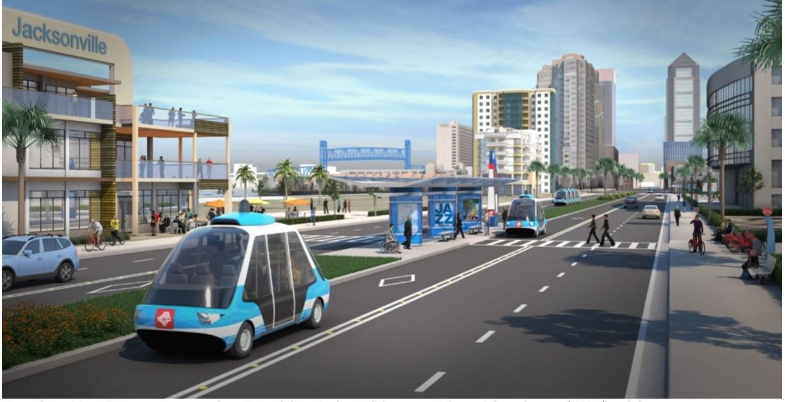
Phase 2 of the U2C will be a full conversion of the Skyway superstructure and eight stations into an elevated roadway for autonomous vehicles stretching from LaVilla across the river to the Southbank. The second phase will also include “the street level connection to Phase 1, the Bay Street Innovation Corridor.” This phase is expected to cost $247 million and will be funded by the 6-cent gas tax the Jacksonville City Council approved in May.
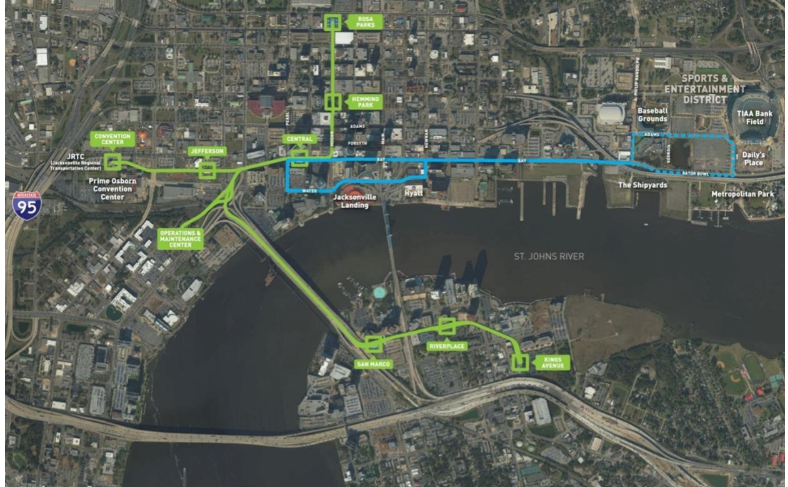
Phase 3 is listed as “TBA” on DOT documents. We do know it will allegedly involve “neighborhood expansions,” and $1.27 million in grant funds were awarded in support of the project. JTA must provide a 50 percent match to the DOT funds.
When all three phases are completed, “the system will expand the current Skyway from a 2.5-mile system to the 10-mile U2C, leveraging the latest autonomous vehicle technologies.”
Construction is slated to begin in January 2024 and will wrap up in the summer of 2025. The third phase is expected to be completed in September 2026.
While those involved with the project are already patting themselves on the back for a job well done, there are some major roadblocks JTA must work through.
The first major roadblock, JTA can’t even buy the $240 million dollars’ worth of autonomous vehicles budgeted for the project, because doing so is technically illegal. The Buy American Act requires all federal agencies to buy, use or produce products made in the United States. There isn’t a single company manufacturing autonomous vehicles in the U.S. So far, JTA’s attempts to get a waiver for European shuttles have been denied. JTA says it has met with two shuttle manufactures in Germany who have shown interest in building a plant in the U.S., but nothing could be done in time to meet the DOT’s deadline. JTA must spend $12.5 million given by the federal agency before Sept. 30, 2025, on Phase 1’s Bay Street Innovation Corridor. JTA claims it is “working diligently with the U.S. DOT and FTA to determine a path forward.”
Another major issue and the reason behind Phase 1’s $16 million increase is due to bad planning. In the beginning JTA wanted to use the existing Skyway operation center as its headquarters for the autonomous vehicle system, but realized it needed to stay open to run the Skyway while the Bay Steet Corridor is being built. The plan is now to build a new operations center on the corner of Bay and Jefferson streets. Of course, the Downtown Development Review Board had issues with the original design, so JTA is still waiting on the board to approve the updated rendering.
Buying non-existent autonomous vehicles, development, pending design approvals, funding and construction must all be done and ready for paying customers in less than two years. As my sister-in-law would say, “God bless your ministry.”
Before I jump to the negative, I’ll start with a few positives regarding the project. JTA has partnered with FSCJ to create collegiate level curriculum for students interested in the industry. The authority is also working with middle and high school STEM students during Autonomous Vehicle Roadshows around town. Students get to check out the technology, go inside and experience a driverless vehicle firsthand. That kind of stuff is great and important, but it is even more important to be realistic.
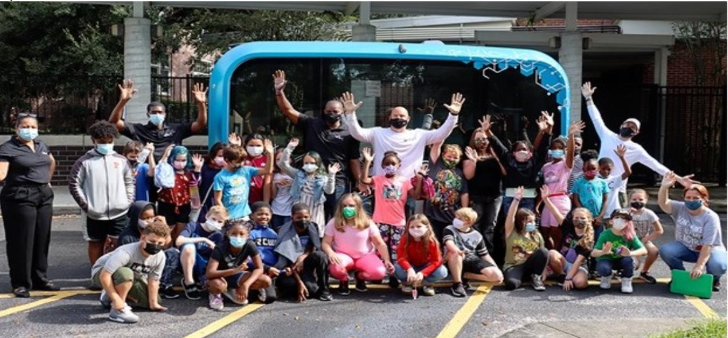
I really do hate to be Jonny Raincloud, but the U2C is an eco-pipedream from the city’s elite. It never will work. Our city is not designed for this type of project. Moreover, no one other than government employees and people working for these companies are pushing for it. Plus, no one wants to ride around in an unreliable electronic toaster moving along at a snail’s pace with nowhere to go.
The argument for this project is basically the same argument made for the Skyway 50 years ago. Wash, rinse & repeat.
According to the Florida Times-Union, back in the 70’s Jacksonville’s city leaders were very worried about traffic congestion on roads and toll bridges, the lack of parking downtown and “air pollution.” So, they came up with a way to solve our city’s alleged traffic and pollution crisis by building a $183 million dollar 4.4-mile people mover to connect “the medical centers on Eighth Street with Riverside, San Marco and the Gator Bowl.” In 1985 Jacksonville was awarded its first grant for the project from the federal government. We never received enough money to build the entire 4.4-mile route but went ahead and built the 2.5-mile section we have today.
Jacksonville’s mayor back in the 1980’s, Jake Godbold, was initially on board for the Skyway project. “The business community thought it would help the downtown, but if I knew then what I know now, I wouldn’t have pushed for it,” Goldbold told the TU. Goldbold isn’t the only former mayor living with regret. Former Mayor Tommy Hazouri, who is our current mayor’s kin, assumed downtown would keep growing, but that didn’t happen. “We all assumed people would always come downtown to go shopping, we didn’t anticipate something like the St. Johns Town Center,” Hazouri said.
The original goal was to expand the Skyway to the Gator Bowl, but the idea was finally tabled in 2002. Former Mayor John Delaney believed the Skyway would have been successful if construction began at the stadium. Delaney says the Skyway was “built in the wrong place and will not work until an extension is done to connect it to the football stadium.”
Despite the criticism, former JTA Chairman Arnold Tritt predicted the Skyway’s success and the authority’s vindication claiming, “I really think in the year 2020, 2010… whenever, people are going to say, ‘What visionaries!’” Well, it is now the year 2023 and the Skyway is still an embarrassing joke. It cost the city close to $200 million to build, more than $14 million a year to operate, it’s free to ride and still no one uses it. Ridership is so low, the fare-free system only operates on weekdays and occasionally runs on a weekend when there is a major event downtown.
This is the same type of arrogance people currently working on the U2C are bloviating in marketing videos on YouTube.
“Like anything new, autonomous technology has its detractors, most from those not involved in the transportation industry or who have worked with AVs in any way. But the public transit, industry professionals, who have been studying and testing it for several years like those at the JTA and elsewhere in Florida, and the nearly 40 agencies across the United States know that this technology works and is the future of transportation,” the marketing puffery says.
If you build it, they will come. Even though the current Skyway proves they won’t.
See, when it comes to spending money taken from you via a tax, bureaucrats know better than you. It is also important to remember, your opinion doesn’t matter because if government employees say an idea will work, it will work. Even if it doesn’t, it does.
Once the system is completed and the Skyway track is redesigned for the autonomous vehicles we cannot yet buy, one major question remains: why would anyone pay to ride it?
There is still nowhere to go and nothing to do downtown. I cannot think of a good enough reason to leave the safety of my personal vehicle in exchange for riding around with strangers in a government sponsored robot van traveling slower than molasses in January. If the U2C went from the Southbank across the river and traveled east to the stadium, it might be worth it on game day. But I still do not think that would work because the autonomous vehicles carry less than 20 people at a time. And that is without wheelchairs or strollers. One JTA is partial to, the Olli, has only four hours of run time! It is the same model being tested on FSCJ’s campus. The company that built the vehicle has since gone belly up due to “lack of demand.”
None of the models featured in JTA’s marketing video can operate in heavy rain or fog. One of the vehicles doesn’t even have the software to operate in the rain. Only one model has an automated wheelchair ramp. All the others, a human must physically attach or lower the ramp, which completely defeats the purpose of a fully “autonomous” vehicle.
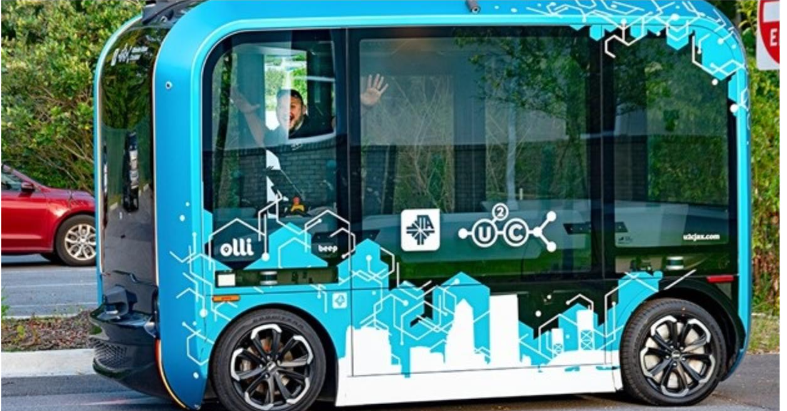
City officials in Gainesville tested a few autonomous vehicles last year. The goal was to shuttle people from a downtown parking lot to the University of Florida and back. It did not go well. People didn’t like the robo-bus’s small size, how slow it traveled or how it blocked the flow of traffic. The bus’s sensors kept getting confused by rain, nearby objects, tree limbs, reflective material, even working lawnmowers stopped the shuttle. Gainesville’s mayor told the local newspaper the system will not work downtown but might have potential connecting neighborhoods to the city’s established main bus line.
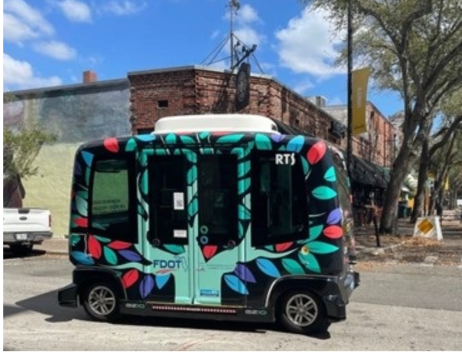
I could understand revamping an outdated system if demand were there. But it isn’t. It never has and it never will. According to Google responses, in 2022, 276,000 people rode the Skyway. That breaks down to about 756 trips a day. In a city of more than 1 million people, is $400 million spent and raising my gas tax 6 cents really worth it for a system only a small fraction of people periodically use?
The idea of an Ultimate Urban Circulator and an Innovation Corridor are pretty amazing. Connecting shopping, entertainment, sports venues, restaurants, hotels and apartments along the North and South banks with a reliable mass transportation system would be wonderful. I have been dreaming of that since I was a teenager. One day, it will happen. But now is not the time. For this to work, the entire downtown infrastructure would need to be rebuilt focusing on residential, shopping, entertainment and safety. The jail must be moved, along with all facilities serving the homeless out of the downtown area. People and business owners will never feel comfortable enough to move downtown until things improve. $400 million dollars’ worth of driverless toaster vans moseying along the bike lane on Bay Street, will not help.
DOT documents claim the U2C’s “inter-connect micro-mobility and transit options to individual desired destinations within Jacksonville improves our health, economy and environment.”
Since the $183 million-dollar Skyway wasn’t up to the task, maybe the $400 million-dollar Ultimate Urban Circulator will be. Although I highly doubt it.









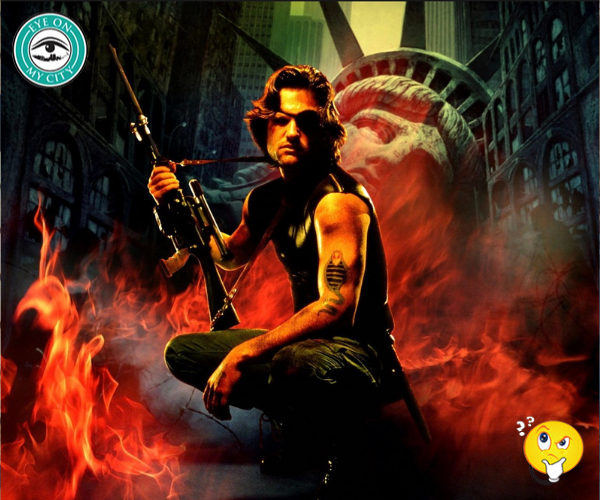

One response to “JTA’s U2C: If You Build It, They Will Come. Well… Probably Not”
I have observed over my 16 years in Jacksonville that the busses usually have only one passenger, the driver. This NEW project appears to be a typical waste of tax payer money for no good return.